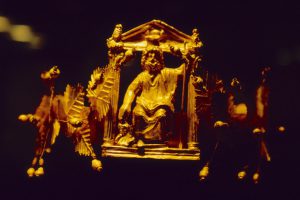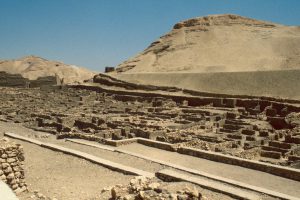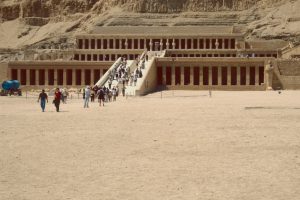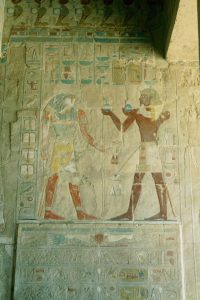The Curse of the Pharao’s
During one of our diving classes my friend
Luciano and myself discussed the idea of going on a diving holiday
somewhere in spring. It did not take long before Egypt grabbed our
attention so we started to look for a trip that fitted us. We found a
special offer for a 2 week holiday to Hurghada but instead of staying
there for the 2 full weeks we decided to split it up and travel the
country for a week before starting the diving. So once our almost 5 hour
flight landed and we had checked in at our hotel we immediately started
to look for ways to get to Cairo. That turned out to be pretty easy so
the same evening we boarded a night bus for the 450km trip to Cairo
where we arrived about 6 hours later.
What better way to start
the exploration of the Egyptian culture than paying a visit to the
Egyptian Museum which houses the world’s largest collection of Pharaonic
antiquities. First we checked out the ground floor and watched an
extensive collection of papyrus and coins used in the ancient world, as
well as statues, tables and sarcophagi.
On the first floor we saw
tombs of several of the pharaoh’s as well as many artifacts from the
Valley of the kings, that we would visit later. In two special rooms we
saw a number of mummies of former kings and of course we could not leave
without admiring the famous mask of Tutankhamun, which is made of 11kg
of pure gold.
The next day we visited
what must be Egypt’s most famous site, the pyramids of Giza, at the
outskirts of Cairo. All three pyramids were built according the same
principle. Aboveground burial chambers, a mortuary temple and a causeway
leading down to a valley temple. Without doubt the pyramids speak to
everybody’s imagination and needless to say both of us were very eager
to explore the site.
As soon as we arrived we
were hassled by touts (so called private guides) and camel drivers who
all wanted our business. It was difficult to make clear to them that we
wanted to walk on our own and the constant hassle made our visit a bit
cumbersome. The next thing that caught our attention was how dirty the
area was and how many plastic bags were laying around and blowing in the
wind. This was certainly not the state we had expected one of the seven
wonders of the ancient world to be in. In some ways we were to late
anyway. For centuries,
the pyramids were encased in smooth limestone, but this was plundered in
our era to build Cairo, it’s a true shame no one can nowadays see the
pyramids in their full glory.
We tried to ignore the
hassling and made our way to the pyramids. It was an impressive sight
indeed seeing them with our own eyes. We entered the Great pyramid of
Giza (aka the pyramid of Cheops) through the Robber’s tunnel and made
our way to the Kings room through a set of narrow, steep and very warm
alleyways.
Once we got out of the
pyramid of Cheops again we admired the smaller pyramids of queens, the
cemeteries and two boat pits. After that we headed back for a closer
look of the great Sphinx and the temple of the Sphinx.
That evening we took the
night train to Luxor where we arrived early in the morning. We found a
picturesque hotel at the west bank of the Nile and after we checked in
started our exploration of the area.
First we took the ferry
back to the east bank and visited the Karnak Temple which was known as
Ipet-isu when it was built. Actually it is a city of temples built over
2000 years from around 2055BC to 100AD. It was dedicated to the Theban
triad of Amun, Mut and Khonsu. It’s the largest religious building ever
made, so it took us a while to visit all sights.
We made our way through the
first pylon, the great court and the Ramesses III Chapel to the
Hypostyle hall and were amazed by the beautiful Hieroglyphs we saw. The
good thing was that once we passed the many private guides outside the
temple we were left alone inside so we could admire the building at our
own pace without being disturbed.
There was so much to be
seen, the Tuthmosis III Hall, The (now dried out) sacred lake, The
Thutmose III Pylon and the Temple of Khonsu. Both of us tried to
fantasize how things must have been here thousands of years ago. The
vast amount of priests, the ceremonies performed to regenerate Amun,
recreate the cosmos and transfer Amun’s power to the Pharaoh. Thousands
of people were waiting outside, waiting for the Pharaoh to emerge from
the Temple sanctuary. It certainly were impressive times, especially if
you belonged to the happy few within the inner circle of the Pharaoh and
his priests.
The next day we decided to
make a donkey tour to the valley of Kings but first entrance tickets had
to be bought. Luciano was extremely keen on visiting the Tomb of
Hatsheput but that was limited to only 50 guests a day in order to
preserve the stunning hieroglyphs. In order to be one of the lucky few
you had to be at the ticket counter at 5:30 in order to buy one of the
much desired tickets. Fortunately this could be arranged for us at a
small fee so we could have a bit of a sleep in. Having said that, life
starts early in Egypt as the heat becomes to much for some very quickly.
As soon as we left the
flatlands surrounding the Nile the landscape became dry and brown. We
started the ascend, comfortably sitting on our donkey while the guide
was leading us towards the valleys. The first stop was the Theban
Necropolis, which was used for ritual burnings during the Pharaonic
Times.
We passed the temple of
Hatsheputh but left visiting that site till our return from the Valley
of Kings. It was impressive though to see it from above and both of us
were extremely liking our trip, in spite of the ever increasing heat.
The last bit into the
valley we needed to cover on foot and this time we really realized how
warm it already was at this early point of the day. Finally a long path
led us through narrow gorges towards the once well hidden valley of
Kings. Here there were many tombs to be visited and both of us were
amazed how the work on these tombs were completed thousands of years in
complete secret and not to be discovered until many many hundreds of
years later.
Totally stunned we kept the
Thomb of Hatsheput for last. We were lucky to have two tickets of the
very limited daily quota but in spite of the hefty fee of 50 US$ we were
only allowed to stay in for about ten minutes and needed to be on the
move constantly. The hieroglyphs were absolutely breathtaking though,
maybe even more so than the hot stale air inside the Tomb.
Back out of the tomb again
we were totally overwhelmed by what we had seen the last couple of
hours. The detail of the hieroglyphs were absolutely stunning to look
at. It made it even more special to know it was a coded language, only
known to a few telling stories about kings and queens, Pharaoh’s and
priests, their constant power struggles, battles, victories and losses.
Our final stop for the day
was the mortuary temple of Queen Hatshepsut, which we saw earlier that
day when passing by on the cliffs above. It is an incomparable monument
of ancient Egypt but also the site of the massacre where 62 people were
killed by extremists in November 1997. Now two and a half year later no
remains of that attack were to be seen so we tried to focus on the
beauty of the site itself. Originally the temple had three levels of
which two have been carefully restorated. At the time of our visit the
top level was still under reconstruction so we could not go there.
In the evening we made a
felucca ride, a traditional wooden boat that offered a quieter and
calmer mood than a motorboat has to offer. It was the perfect way to
finish of our stay in Luxor. Whilst enjoying an extremely beautiful
sunset both of us were fantasizing about times long gone, a time of
which we were only able to see some of the remainders as most of it had
been plundered and vanished throughout the years.
We talked to our boatsman
about our wish to visit Abu Simbel and he ensured us it was no problem
for him to arrange. As things had been taken care of so well during the
felucca tour we decided to give him the business and let him join us
further south.
Next day we started our
trip to Abu Simbel. First we visited the temple of Luxor at the site of
the famous city of Thebes. Although the mud-brick houses and palaces
have disappeared its stone temples have survived. The most beautiful one
is the Temple of Luxor so we did not want to leave the area without a
visit. Waiting in line for the ticket counter I once again had an argue
with an Egyptian tour leader who tried to force her way to the beginning
of the queue. She was a tour leader and therefor of great importance. I
corrected her that I was a tourist and therefor of even greater
importance. Without tourists there would be no tour leaders so I did not
allow her to pass me which left her agitated and grumpy, but so were
we. Unsurprisingly we bought our tickets before it was her turn…
We continued our trip
following the Nile and late in the afternoon we made it to the Aswan
dam. It’s Egypt’s most important dam which not only prevents the Nile
from flooding every year during late summer but it also has a major
impact on the economy and culture of Egypt.
By now, according to the
planning we should already have been in Abu Simbel but that was still a 4
hour trip one way to go. We were now halfway our holiday and decided
not to sacrifice at least another 2 days of diving so we cancelled the
remainder of our trip and took a night bus to Hurghada. Our bus was
driving in a convoy to be more secure from terrorist attacks and there
were regular check-ups at military and police posts. During these
check-ups we had to cover ourself and pretend sleeping as we were
traveling in a local bus, not really meant for tourists. It was a bit
surreal as this was not mentioned by our guide before. It seemed that
organizing this trip had gone way beyond his capacity.
We arrived safely in
Hurghada in the morning and decided to rest for the remainder of the
day. The next days we went diving twice a day. The underwater scenery
was amazing end both of us enjoyed it thoroughly. This was really
vacation time. Enjoying the sun whilst en route to the dive site,
followed by a dive in which one pair of eyes was simply not enough. It
was the first time for the both of us we were diving in tropical waters
and there was so much more to be seen than the cold murky waters of the
Grevelingenmeer in the Netherlands where we were used to. After the
first dive we enjoyed some more sun whilst we had lunch and waited for
the second dive. Late afternoons we returned to the hotel where we
relaxed at the pool.
The highlight of our diving
week would be a day tour to the wreck of the Thistlegorm. Unfortunately
I was not very well on that day so I had to skip the first dive, not
feeling able to make the 30m descent. The second dive in the afternoon
Luciano convinced me to go along which I did so the long boat trip to
the dive site was not made for nothing. Gladly the day after I felt much
better so we could continue our diving together for the last couple of
days.
During the evenings we went
out a couple of times to the old center of Hurghada but pretty soon
were fed up by the merchants who hassled us non stop in a quite
aggressive manner to get us into their shops and told us we were
insulting Egyptian hospitality when we ignored them. It simply was
impossible to stroll through the streets without the feeling being a
walking wallet. At the end we gave up and stayed at the hotel for
dinner.
Egypt, the country with
without doubt some of the most iconic archeological sites and treasures
in the world. Unfortunately they have been plundered for hundreds of
years and little of the treasures are still to be seen. When visiting
the sites one has to be vigilant as terrorist attacks are always a
possibility, as the massacre at the Temple of Hatshepsut had proven. We
had seen the extreme security measures ourselves when driving back at
night to Hurghada. Finally most historic sites and tourist areas are
surrounded by some of the most disrespectful and irritating touts,
merchants and so called private tour guides. They really put a dark
cloud above our visit. Although we certainly enjoyed our trip neither of
us thought we we would ever make the effort to return to Egypt.
It seems that somehow Egypt
has enough of it’s exploitation and plundering the last couple of
centuries and something or someone is trying to stop people from
visiting and enjoying these impressive places. Is that the curse of the
Pharaoh’s?





















































































